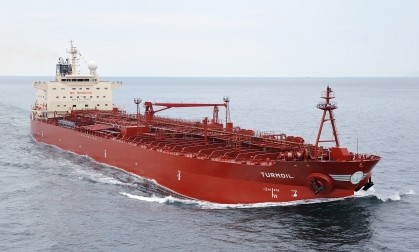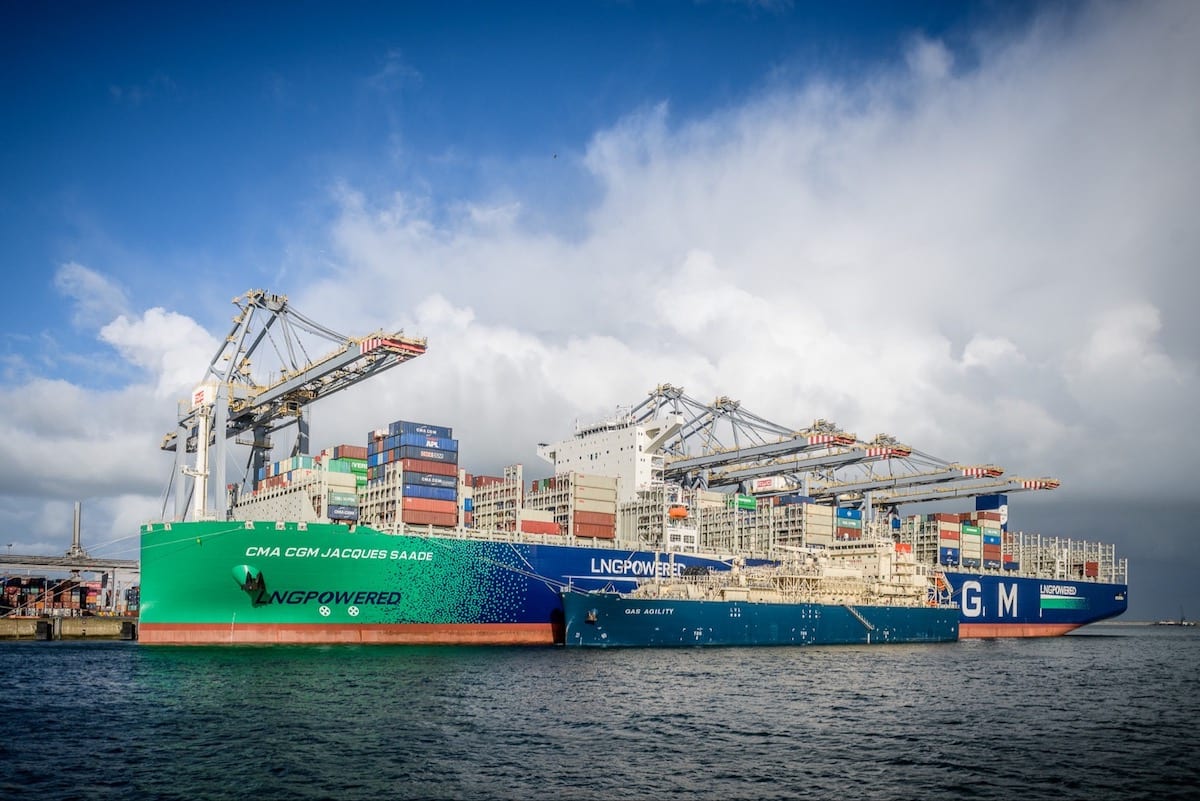File photo of a medium range clean products tanker, image courtesy Transpetrol
(Bloomberg) — Exports of diesel fuel from the U.S. Gulf Coast are poised to climb as refineries returning from maintenance boost production, widening the price gap between the Gulf and Europe while freight rates hover near a six-month low.
Plants are ramping up after planned work in the first quarter that took 1.13 million barrels a day of capacity offline, 45 percent above the five-year average, according to IIR Energy. The rate to book a vessel from the Gulf to Europe dropped 33 percent to a 2012 low on March 20, Baltic Exchange data show.
Refineries including Motiva Enterprises LLC’s Port Arthur, Texas, plant and Chevron Corp.’s Pascagoula, Mississippi, site are expected to complete work next month, boosting output at a time when European maintenance may peak. Shipments to Europe and Latin America may keep the so-called arbitrage open, sustaining profit margins for refiners even as domestic demand slides.
“There are increasing runs in the Gulf Coast, lower runs in Europe and demand increasing from the Southern Hemisphere,” Tom Finlon, director of Energy Analytics Group Ltd., said in a phone interview on March 22 from Jupiter, Florida. “Low freight rates help the arbitrage opportunity in the Gulf.”
Ultra-low-sulfur diesel swaps that settle based on prices in the Gulf Coast spot market slipped to $3.0054 a gallon ($919.65 per metric ton) yesterday, according to fair-value data compiled by Bloomberg. Swaps for diesel cargoes delivered in Northwest Europe were $949.63 a ton.
Shipping Profit
Including freight costs, the profit to buy diesel and ship it to Northwest Europe was $9.33 per metric ton, according to data compiled by Bloomberg. That doesn’t include additional expense to blend the fuel to European specifications.
“The arb to Europe is going to be open for a while, certainly through the month of April,” Finlon said.
Crude and other feedstocks processed by Gulf Coast refiners jumped to 7.84 million barrels a day last week, the highest level for this time of year in Energy Information Administration data back to 1993.
Across the U.S., plant rates rose to 85.7 percent in the week ended March 22 from 81 percent as of March 8, the lowest level since September 2011, EIA data show.
The boost in refinery production comes as U.S. consumption has yet to recover from the worst economic downturn since the Great Depression, encouraging refiners to export excess fuel to Europe, where plant capacity is declining. Distillate demand in December was 8.4 percent lower than a year earlier.
IIR, an energy information provider based in Sugar Land, Texas, estimates maintenance from April to June will slide to an average of 676,000 barrels a day.
’Heavy Maintenance’
“We’ve had very heavy maintenance and now we’re going to see these refineries start to come back on,” Carl Larry, broker with Atlas Commodities LLC, said in a phone interview from Houston. “As long as U.S. demand stays low and Europe is in turnaround, we’re probably going to ship there.”
Traders and oil companies will hire eight tankers to load diesel fuel for the Gulf Coast-Europe voyage in the two weeks to April 3, according to the median estimate in a survey of five shipbrokers who specialize in arranging diesel cargoes. The number of ships seeking charters will be 32, up from 31 in early March. The survey is based on a so-called single voyage, or spot, charters.
European Work
Six European refineries with a total capacity of about 1.51 million barrels a day are expected to conduct maintenance during the month of April, according to Emirates National Oil Company. Among the biggest plants are Total SA’s Antwerp, Belgium, refinery, PCK Raffinerie GmbH’s Schwedt, Germany, site, and TNK- BP Ltd.’s Ryazan, Russia, facility.
“The market is currently well supplied, with normal demand seen in the U.K., Germany and France,” an mid-March ENOC report showed. “April maintenance is expected to lower production in Germany, Poland and Italy.”
Motiva’s 600,000-barrel-a-day Port Arthur refinery, the largest in the U.S., began 38 days of work on a sulfur recovery unit, delayed coker and pipestill No. 2 around Feb. 14. Chevron’s Pascagoula plant was conducting a turnaround on a crude distillation unit, vacuum distillation unit, coker and hydrotreater this month.
Cargoes will also head to Latin America, where the EIA forecast fuel consumption will grow 4 percent to 7.01 million barrels a day in the second quarter from a year earlier.
Latin America
Latin American refinery throughput is expected to average 5.9 million barrels a day in 2013, about 70,000 barrels more than a year earlier, according to data compiled by Energy Security Analysis, Inc. The increase is a result of fewer refinery disruptions and the expectation for a full return of Petroleos de Venezuela SA’s 645,000-barrel-a-day Amuay plant in the second half of the year, Christopher Barber, a senior analyst at Energy Security Analysis, Inc., said by phone.
Amuay, part of PDVSA’s 955,000-barrel-a-day Paraguana complex, which shut twice since February, is processing about 352,000 barrels a day, according to a company statement. The refinery has been operating at reduced rates since an August explosion.
“It’s not that we’ll see runs increase but they won’t fall off as much,” said Barber, who is based in Boston. “That should keep a steady flow of exports to Latin America.”
Shipping Rates
Booking rates for the voyage rallied to 86.43 Worldscale points yesterday from 60.54 March 20 as demand for cargoes to service the U.S. Gulf Coast increased, according to George P. Los, shipping analyst with Charles R. Weber Co. They fell to 60.54 on March 20, the lowest since Sept. 13, 2012.
The Worldscale points indicate what percentage of a dollars-a-ton flat rate set for various shipping routes once a year by the Worldscale Association that traders booking tankers are paying.
“The activity strength can be attributed to the fact that the Gulf Coast refineries are preparing for an end to a strong seasonal maintenance period,” said Los, who is based in Stamford, Connecticut.
The fixture of medium-range tankers in the Gulf rose to 28 last week from 16 in the week-earlier period, a weekly report from the company showed. Nine ships were bound for points in Europe, while eight headed for Latin America and five were sent to the Caribbean, according to the report.
“Shipping is still relatively inexpensive,” said Bill Day, a San Antonio, Texas-based spokesman for Valero Energy Corp. “Keep in mind that the U.S. has been importing much less crude oil and refined product in recent months, so there are ships available. Valero watches the arbs closely.”
The European turnaround season is “definitely a good sign,” said Barber. “The capacity to produce diesel is huge now on the Gulf and Europe is always short. It creates a bigger export market and it’s a strategic move for Gulf refiners.”
– Christine Harvey, Copyright 2013 Bloomberg.
Unlock Exclusive Insights Today!
Join the gCaptain Club for curated content, insider opinions, and vibrant community discussions.

 Join The Club
Join The Club













